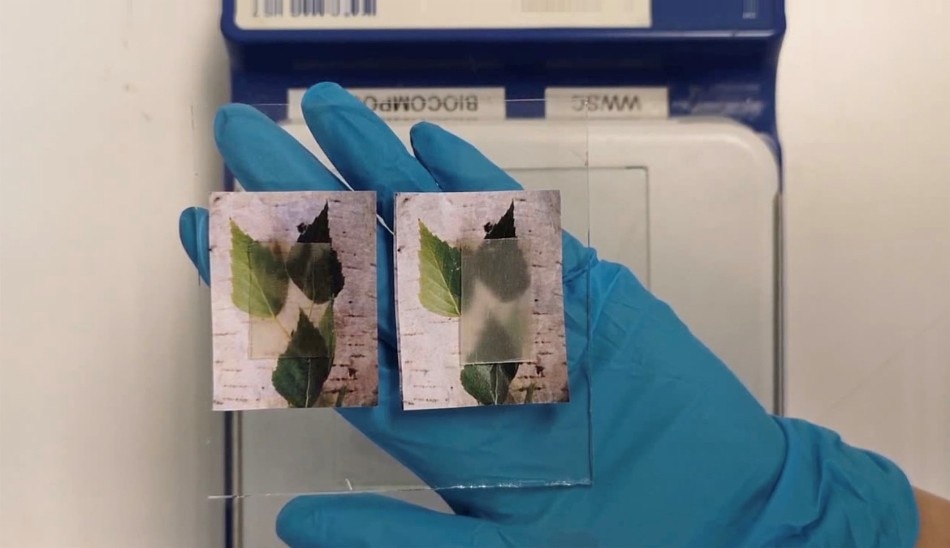Apr 4 2019
It is generally believed that wood is more suitable for log cabins than for contemporary buildings; however, an exceptionally treated type of timber could well become the trendy building material of the future.
 A new transparent wood becomes cloudier (right) upon the release of stored heat. (Image credit: American Chemical Society)
A new transparent wood becomes cloudier (right) upon the release of stored heat. (Image credit: American Chemical Society)
Now, researchers have reported a unique kind of transparent wood that has the ability to transmit light and, at the same time, absorbs and emits heat, possibly reducing energy costs. The novel material is biodegradable and can tolerate heavy loads, thus paving the way for its ultimate application in numerous buildings, including eco-friendly homes.
The results will be presented at the American Chemical Society (ACS) Spring 2019 National Meeting & Exposition by the researchers. The world’s largest scientific society, ACS, is conducting the meeting through Thursday, April 4th, 2019 which will feature almost 13,000 presentations on many different science topics.
Back in 2016, we showed that transparent wood has excellent thermal-insulating properties compared with glass, combined with high optical transmittance. In this work, we tried to reduce the building energy consumption even more by incorporating a material that can absorb, store and release heat.
Céline Montanari, PhD Student, KTH Royal Institute of Technology
Montanari will present the study findings at the ACS meeting.
Globally, as economic development progresses, so does energy consumption. A large part of this energy is used for lighting, heating and cooling offices, homes, and other kinds of buildings.
Although glass windows are able to brighten and heat homes by transmitting light, they cannot store energy for use after the sunset.
Three years ago, an optically transparent wood was reported in the ACS journal Biomacromolecules by lead investigator Lars Berglund, PhD, and coworkers at KTH Royal Institute of Technology in Stockholm, Sweden. To develop the material, the team removed a light-absorbing component known as lignin from the balsa wood’s cell walls. Then, to minimize the scattering of light, the researchers integrated acrylic into the porous wood scaffold. While they were able to view through the material, it was sufficiently hazy to allow privacy if utilized as a key building material. Moreover, favorable mechanical properties present in the transparent wood allow it to tolerate heavy loads.
Taking a cue from this work, Berglund and Montanari added a polymer known as polyethylene glycol, or PEG, to the de-lignified wood.
We chose PEG because of its ability to store heat, but also because of its high affinity for wood. In Stockholm, there’s a really old ship called Vasa, and the scientists used PEG to stabilize the wood. So we knew that PEG can go really deep into the wood cells.
Céline Montanari, PhD Student, KTH Royal Institute of Technology
PEG is referred to as a “phase-change material”. This solid polymer melts at a temperature of 80 °F and stores energy in the process. Different types of PEGs can be used to adjust the melting temperature.
“During a sunny day, the material will absorb heat before it reaches the indoor space, and the indoors will be cooler than outside,” explained Montanari. “And at night, the reverse occurs –– the PEG becomes solid and releases heat indoors so that you can maintain a constant temperature in the house.”
The PEG was subsequently encapsulated within the de-lignified wood scaffold, which ensured that the polymer does not leak at the time of phase transitions. In order to protect the polymer from humidity, the researchers added acrylic into the material. The modified wood, akin to their previous version, was transparent, albeit somewhat hazy, and robust, but still had the added benefit of storing heat.
The team pointed out that compared to other building materials like glass, concrete, and plastic, the new transparent wood has the ability to be more environmentally friendly. Apart from its thermal-storage capabilities, the transparent wood can be disposed of more easily once it has served its purpose.
The PEG and wood are both bio-based and biodegradable. The only part that is not biodegradable is the acrylic, but this could be replaced by another bio-based polymer.
Lars Berglund, PhD and Lead Investigator, KTH Royal Institute of Technology
Presently, the aim is to scale up the production process so that it can be industrially viable. According to the researchers, in just five years, transparent wood might well be available for niche applications in interior design. In addition, the team is also attempting to boost the material’s storage capacity to render it even more energy-efficient.
The investigators acknowledged funding and support from the European Research Council and the Wallenberg Foundations.
Headline Science - Transparent Wood
Video credit: American Chemical Society